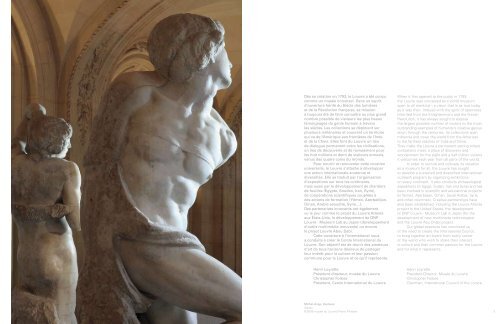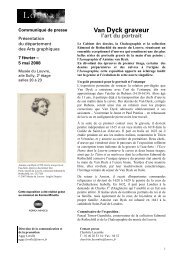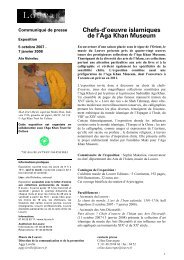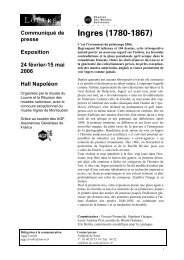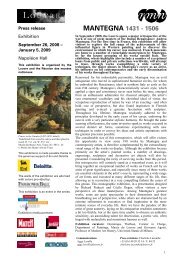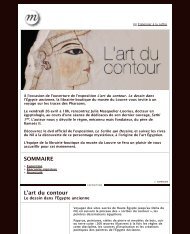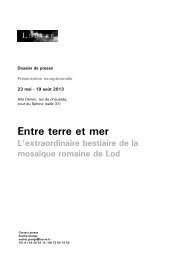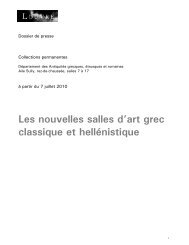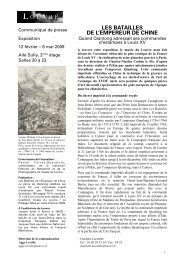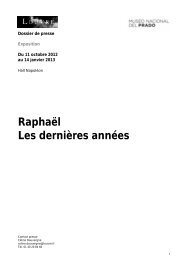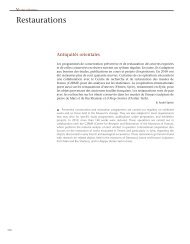Cercle International du Louvre - Musée du Louvre
Cercle International du Louvre - Musée du Louvre
Cercle International du Louvre - Musée du Louvre
Create successful ePaper yourself
Turn your PDF publications into a flip-book with our unique Google optimized e-Paper software.
Dès sa création en 1793, le <strong>Louvre</strong> a été conçu<br />
comme un musée universel. Dans un esprit<br />
d’ouverture hérité <strong>du</strong> Siècle des lumières<br />
et de la Révolution française, sa mission<br />
a toujours été de faire connaître au plus grand<br />
nombre possible de visiteurs les plus beaux<br />
témoignages <strong>du</strong> génie humain à travers<br />
les siècles. Les collections se déploient sur<br />
plusieurs millénaires et couvrent un territoire<br />
qui va de l’Amérique aux frontières de l’Inde<br />
et de la Chine. Elles font <strong>du</strong> <strong>Louvre</strong> un lieu<br />
de dialogue permanent entre les civilisations,<br />
un lieu de découverte et de ravissement pour<br />
les huit millions et demi de visiteurs annuels,<br />
venus des quatre coins <strong>du</strong> monde.<br />
Pour nourrir et renouveler cette vocation<br />
universelle, le <strong>Louvre</strong> s’attache à développer<br />
une action internationale soutenue et<br />
diversifiée. Elle se tra<strong>du</strong>it par l’organisation<br />
d’expositions sur tous les continents,<br />
mais aussi par le développement de chantiers<br />
de fouilles (Égypte, Soudan, Iran, Syrie),<br />
de coopérations scientifiques couplées à<br />
des actions de formation (Yémen, Azerbaïdjan,<br />
Oman, Arabie saoudite, Syrie…).<br />
Des partenariats innovants ont également<br />
vu le jour comme le projet <strong>du</strong> <strong>Louvre</strong> Atlanta<br />
aux États-Unis, le développement de DNP<br />
<strong>Louvre</strong> - Museum Lab au Japon (développement<br />
d’outils multimédia innovants) ou encore<br />
le projet <strong>Louvre</strong> Abou Dabi.<br />
Cette ouverture à l’international nous<br />
a con<strong>du</strong>its à créer le <strong>Cercle</strong> <strong>International</strong> <strong>du</strong><br />
<strong>Louvre</strong>. Son objectif est de réunir des amateurs<br />
d’art de tous horizons désireux de partager<br />
leur intérêt pour la culture et leur passion<br />
commune pour le <strong>Louvre</strong> et ce qu’il représente.<br />
Henri Loyrette<br />
Président-directeur, musée <strong>du</strong> <strong>Louvre</strong><br />
Christopher Forbes<br />
Président, <strong>Cercle</strong> <strong>International</strong> <strong>du</strong> <strong>Louvre</strong><br />
When it first opened to the public in 1793,<br />
the <strong>Louvre</strong> was conceived as a world museum<br />
open to all mankind – a vision that is as true today<br />
as it was then. Imbued with the spirit of openness<br />
inherited from the Enlightenment and the French<br />
Revolution, it has always sought to expose<br />
the largest possible number of visitors to the most<br />
outstanding examples of humanity’s creative genius<br />
down through the centuries. Its collections span<br />
millennia and cover the world from the Americas<br />
to the farthest reaches of India and China.<br />
They make the <strong>Louvre</strong> a permanent setting where<br />
civilizations meet, a place of discovery and<br />
wonderment for the eight and a half million visitors<br />
it welcomes each year from all parts of the world.<br />
In order to nurture and cultivate its vocation<br />
as a museum for all, the <strong>Louvre</strong> has sought<br />
to develop a sustained and diversified international<br />
outreach program by organizing exhibitions<br />
on every continent. It also con<strong>du</strong>cts archaeological<br />
expeditions (in Egypt, Sudan, Iran and Syria) and has<br />
been involved in scientific and e<strong>du</strong>cational projects<br />
(in Yemen, Azerbaijan, Oman, Saudi Arabia, Syria,<br />
and other countries). Creative partnerships have<br />
also been established, including the <strong>Louvre</strong> Atlanta<br />
project in the United States, the development<br />
of DNP <strong>Louvre</strong> - Museum Lab in Japan (for the<br />
development of new multimedia technologies)<br />
and the <strong>Louvre</strong> Abu Dhabi project.<br />
Our global exposure has convinced us<br />
of the need to create the <strong>International</strong> Council,<br />
to bring together art lovers from every corner<br />
of the world who wish to share their interest<br />
in culture and their common passion for the <strong>Louvre</strong><br />
and for what it represents.<br />
Henri Loyrette<br />
President-Director, <strong>Musée</strong> <strong>du</strong> <strong>Louvre</strong><br />
Christopher Forbes<br />
Chairman, <strong>International</strong> Council of the <strong>Louvre</strong><br />
Michel-Ange, Esclaves<br />
Slaves<br />
© 2006 musée <strong>du</strong> <strong>Louvre</strong> / Pierre Philibert 3


